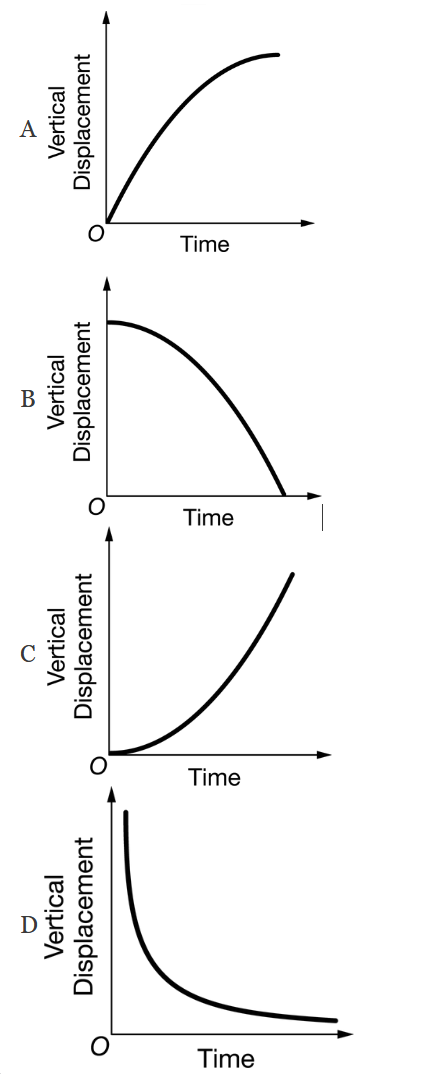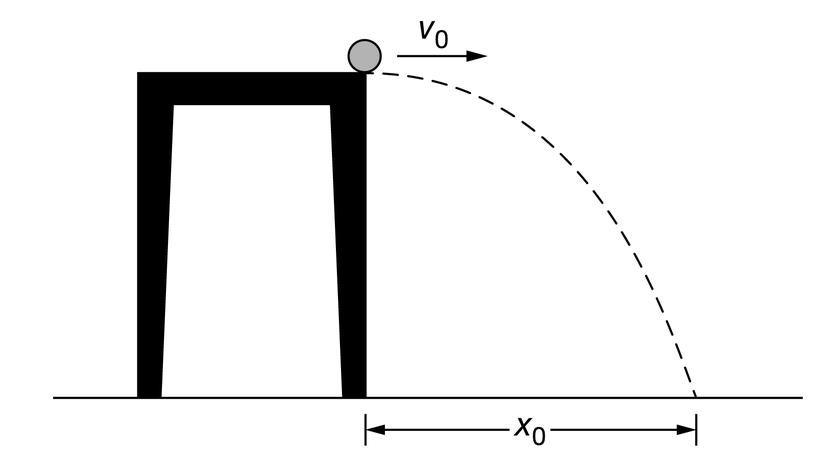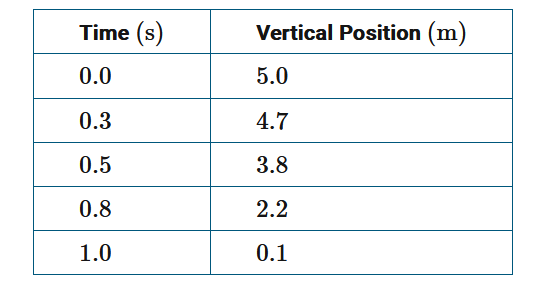Question
Rock X is released from rest at the top of a cliff that is on Earth. A short time later, Rock Y is released from rest from the same location as Rock X . Both rocks fall for several seconds before landing on the ground directly below the cliff. Frictional forces are considered to be negligible.

Which of the following graphs best represents the vertical displacement of Rock X as a function of time starting from immediately after the rock is released from rest? Take the positive direction to be downward.
▶️Answer/Explanation
Ans:C
The slope of the displacement versus time graph should initially be zero or horizontal to indicate that the initial speed of the rock is zero. This particular graph indicates the correct initial speed of the rock. Since the rock is released from rest, it should fall in the downward (positive) direction, and the slope should increase in the positive direction since the acceleration due to gravity vector is also pointing in the positive direction. This graph displays all of the features that have been previously described.
Question
Toy car W travels across a horizontal surface with an acceleration of aw after starting from rest. Toy car Z travels across the same surface toward car W with an acceleration of az after starting from rest. Car W is separated from car Z by a distance d . Which of the following pairs of equations could be used to determine the location on the horizontal surface where the two cars will meet, and why?
A. \(x=x_0+v_0xt+\frac{1}{2}a_xt^2\) for car W, and \(x=x_0+v_{0x}t+\frac{1}{2}a_xt^2\) for car Z. Since the cars will meet at the same time, solving for t in one equation and placing the new expression for t into the other equation will eliminate all unknown variables except x.
B. \(x=x_0+v_0xt+\frac{1}{2}a_xt^2\) for car W, and \(Δx=x−x_0\) for car Z. Since the separation distance is known between both cars, the displacement for car Z can be used in the equation for car W so that the time at which the cars meet can be determined. Once known, the time can be used to determine the meeting location.
C. \(Δx=x−x_0\) for car W, and \(x=x_0+v_0xt+\frac{1}{2}a_xt^2\) for car Z. Since the separation distance is known between both cars, the displacement for car W can be used in the equation for car Z so that the time at which the cars meet can be determined. Once known, the time can be used to determine the meeting location.
D. \(Δx=x−x_0\) for car W, and Δx=x−x0 for car Z . Since the location at which the cars meet represents the final position of both cars, the separation distance for both cars can be substituted into both equations to determine the final position of both cars.
▶️Answer/Explanation
Ans:A
The following application of both equations may be used to determine the position at which the two cars meet.
\(x=x_0+v_0xt+\frac{1}{2}a_xt^2\) \(x=x_0+v_0xt+\frac{1}{2}a_xt^2\)
For car W: \(x=(0)+(0)t+\frac{1}{2}a_Wt^2\) For car Z: \(x=d+(0)t−\frac{1}{2}a_Zt^2\)
\(x=\frac{1}{2}a_Wt^2\) \(x=d−\frac{1}{2}a_Z(\frac{2x}{a_W})\)
\(t=\sqrt{\frac{2x}{a_W}}\) \(x+\frac{a_Z}{a_W}x=d\)
\(x=\frac{d}{1+\frac{a_Z}{a_W}}\)
Question

A ball traveling at a speed \(ν_0\) rolls off a desk and lands at a horizontal distance \(x_0\) away from the desk, as shown in the figure. The ball is then rolled off of the same desk at a speed of \(3v_0\).
At what horizontal distance will the ball land from the table?
A \(x_0\)
B \(3x_0\)
C \(6x_0\)
D \(9x_0\)
▶️Answer/Explanation
Ans:B
The horizontal distance can be determined by applying the following kinematic equation: \(x=x_0+v_{0x}t+\frac{1}{2}a_xt^2\) . In both situations, the initial position of the ball can be considered as zero, and the ball does not experience a horizontal acceleration. Since the ball’s height above the ground remains constant in both situations, the time it takes for the ball to hit the ground will be the same in both situations. Therefore, the following relationship can be concluded: \(x~v_{0x}\) . Therefore, if the initial speed of the ball is increased by a factor of 3, then the horizontal distance traveled by the ball should be increased by a factor of 3.
Question
A student drops a rock from rest at a distance h above the ground such that the rock hits the ground at time \(t_0\). At what distance above the ground should the rock be dropped such that it hits the ground at a time \(2t_0\) after it is released from rest?
A \(h\)
B \(2h\)
C \(3h\)
D \(4h\)
▶️Answer/Explanation
Ans:D
One must first determine the relationship between the distance fallen, h, and the time it takes the rock to hit the ground when released from rest. Therefore, an application of a correct kinematic equation should be used: \(y=y_0+v_0t+\frac{1}{2}at^2\). For distance h, this kinematic equation translates to \(0=h+0(t_0)+\frac{1}{2}(−g)(t^2_0)\), where ground level is taken as a position of zero. Hence, \(h=\frac{1}{2}gt^2_0\). For the rock when it falls for a time of \(2t_0\), an application of the same equation should be used to solve for h.
\(0=y+0(2t_0)+\frac{1}{2}(−g)(2t_0)^2\)
\(y=\frac{1}{2}(g)(2t_0)^2\)
\(y=4(\frac{1}{2}gt^2_0)=4h\)
Question

The table shows the vertical position as a function of time for an object that is dropped from a height of 5 m. A student must determine the acceleration of the object. Which of the following procedures could the student use to make the determination? Justify your selections. Select two answers.
A Create a graph of y as a function of \(t^2\) , since the slope will be equal to the acceleration due to gravity.
B Use \(\bar{v_y}=\frac{Δy}{Δt}\) to determine the average vertical speed of the ball, and then divide the average speed by the time in which the ball was in the air, since the average speed and time interval is used to determine an object’s acceleration.
C Use \(y=y_0+v_{y0}t+\frac{1}{2}a_yt^2\) , since all quantities are known except for the acceleration due to gravity.
D Create a position-versus-time graph of the ball’s motion, and use the data to create a velocity-versus-time graph of the ball’s motion, since the slope of the velocity-versus-time graph represents the acceleration.
▶️Answer/Explanation
Ans:D
This method represents a graphical approach for determining the acceleration of an object. Since the slope of a velocity-versus-time graph represents the change in velocity per unit of time of an object, the slope of a velocity-versus-time graph represents the acceleration of the object under consideration.
